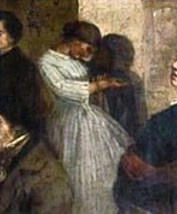The Painter's Studio, much like A Burial at Ornans, is hailed as a masterpiece of the Realist movement.
In this painting, Courbet reimagines an episode of The Last Judgement - where Christ judges all souls, sending some to Heaven and others to Hell.
He replaces the Biblical figures with contemporary subjects.
He also represents himself, as the judge, at the centre of the composition.
To his left, he portrays those he condemns : art critics (symbolized by the skull on the newspaper), the teachers of the Academy of Art (indicated by the sculpture at the back), the Romantics (suggested by the musical instruments on the floor), and Emperor Napoleon III (represented as the man sitting on a chair beside the dog).
To his right, Courbet depicts the ideals he wants to save : Innocence (represented by the child), Truth (embodied by the naked model), artistic freedom (symbolized by the landscape on the canvass), poetry (shown through poet Charles Baudelaire reading a book), art collectors (illustrated by the well-dressed couple observing the scene), free love (depicted by the embracing couple).
Fun fact : can you see the ghostly figure emerging from the darkness in the bottom right, above the man reading a book?
It’s Baudelaire’s mistress, Jeanne Dorval.
Although she was originally included in the painting, Courbet removed her at Baudelaire's request.
However, over time, as the painting ages, she reappears!















.jpg)